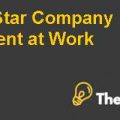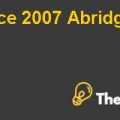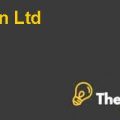
Introduction and description of the organization:
The paper is based on various operational problems experienced by Nike as the leading manufacturer of shoes and other sports equipment in the world particularly related to implementation of a new software application. The basic purpose of implementing new software was to streamline its manufacturing and supply chain process. The basic sources for manufacturing are at the locations like developing Asian countries such as Korea and Taiwan. As a result of this factor, the supply chain of the company is complicated and so are the operations. In this system, the company has to place orders at least six months before the delivery date. The orders are manufactured in Asian countries and then shipped back to the retailers.
“Operations managers often have an ambivalent attitude towards inventories” (Slack, et al., 2013, p. 368). On the one hand, miscommunication in the supply chain invariably results in an increase in working capital. Thus, it is extremely crucial for companies to have a proper control on inventory as it helps in decreasing cost that in turn will increase the profit margins of companies. As far as the footwear retailers are concerned, they have to cope-up with inventories in terms of managing designs and categorizing the shoes according to their types. For the retailers in footwear industry, management of assortment has become the biggest challenge in the recent years. The paper will help retailers in the footwear industry to understand the problems related to managing inventory and the concepts to solve it. The paper will draw upon concepts and models studied in the course such as forecasting, inventory management, and distribution, dealing with uncertainty, reverse logistics, and customer service. It will also explore the Tools and techniques examined in our course, including the Economic Order Quantity Model (EOQ), the Supply Chain Operations Reference Model (SCOR) and the factors directly impacting inventory such as cost, order size, forecasting, capacity planning, and production scheduling.
Assumptions and scope:
The footwear industry is dominated by few of the players that are Nike, Reebok and Adidas that account for approximately 83% of the market share in terms of revenues. Nike has been founded almost after two decades of Adidas foundation but still the company holds a larger market share in terms of revenues. In addition to this, Reebok and Nike are said to be the ones who have set the industry benchmarks. However, the industry has come to its saturation point particularly in the U.S as upcoming companies have taken advantage of it. Still, Nike has succeeded to survive in the market with having a largest share in the footwear industry.
Major issues:
From 2000 till present, Nike has lost over $100 million in sales due to poor inventory management. Although, it might be tricky to grasp from the perspectives of a retail giant, even smaller companies share the same blunder. To strategically align and efficiently implement a better inventory management system, the company must address the following specific issues:
- How can Nike improve their inventory turnovers thus, reducing the working capital required?
- How can a company reduce its risk associated with stock becoming obsolete, deteriorated, and lost?
- Examine ways to leverage the trends, tools, and techniques in global markets to foster greater strategic competitiveness.
- Examine alternative ways to cope with demand fluctuation.
- How can the company plan and control capacity levels better?
- How can the company align its internal processes with supply-demand relationships?
- How can the company foster greater channel alignment and operational efficiency?
Objectives:
With the help of this paper, Nike would be able to find ways of making improvements in their inventory issues and that helps in reducing Nike’s working capital. In addition to this, it will also help Nike in making reductions related to risk connected with the extra stock that has been deteriorated, lost or obsolete. Another objective of this paper is to identify various ways through which the company can leverage the techniques to achieve competitive advantage in the market. The company has faced issues related to demand forecasting and software implementation thus, this paper will help the company in examining the alternative ways to deal with it. Along with this, it will also help the company............................
This is just a sample partial case solution. Please place the order on the website to order your own originally done case solution.












